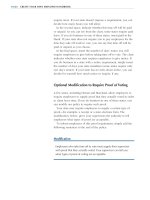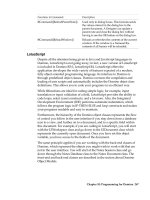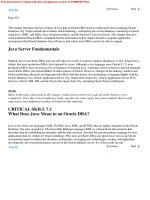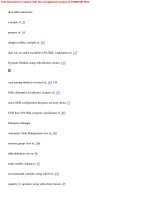DIGITAL CCTV A Security Professional’s Guide phần 5 docx
Bạn đang xem bản rút gọn của tài liệu. Xem và tải ngay bản đầy đủ của tài liệu tại đây (240.29 KB, 32 trang )
Guided Video Transmission 115
for distances of approximately up to 750 or 1,000 feet, depending on
which manufacturer you ask. It will be necessary to choose the
correct coaxial cable for the job at hand. 75 ohm impedance cable is
the standard used in CCTV systems. RG is the cable specifi cation
for use as a radio guide, and the numerical value distinguishes the
specifi cations of each individual cable. Even though each cable has
its own number, characteristics, and size, there is no difference in
the way these different numbered cables work.
Coaxial cable is used primarily for the transmission of analog
video. The most common place it will be seen, even with digital
video systems, is from the camera to the control equipment. Since
many DVRs still require an analog video input, they are still
equipped with BNC connectors for the connection of coaxial cables.
Some new DVRs will allow for inputs from analog and digital
cameras, so until analog cameras are replaced completely with
digital output cameras, coaxial cable will still be very common.
Optical Fiber
Optical fi ber is a thin, fl exible material used to guide optical rays.
Fiber optic transmission was designed to transmit digital signals
in the form of pulses of light. A fi ber optic cable contains one or
more hair-thin strands of glass fi ber, each wrapped within a plastic
tube and an external coating, and capable of transmitting mes-
sages modulated onto light waves. See Figure 7-2.
Figure 7-2 Optical Fiber With Cladding
116 Digital CCTV
Optical fi ber is made up of a cylindrical cross-section with
three concentric links:
●
Core—the innermost section containing one or more very
thin strands or fi bers
●
Cladding—a plastic or glass coating with optical proper-
ties that surrounds each strand
●
Jacket—the outermost layer made of plastic and other
materials that surrounds one or more claddings and pro-
tects them from environmental elements like moisture,
cuts, and crushing.
Fiber optic cables are much thinner and lighter than metal wires
and can carry far more information than copper wire. For longer
distance, fi ber optic cables can be used to transmit video signals
without interference from ground loops, lightning hazards, and
man made noise. Optical fi bers are not affected by interference
from electromagnetic sources.
FDDI Fiber Distributed Data Interface (FDDI) refers to a set of
ANSI protocols for sending digital data over fi ber optic cable.
These networks can support data rates of up to 100 Mbps and are
often used as the basis for wide-area networks.
FDDI-2 FDDI-2 supports the transmission of voice, video, and
data.
Another variation of FDDI called FDDI Full Duplex Technol-
ogy (FFDT) can potentially support data rates up to 200 Mbps.
FTTP Fiber to the Premises (FTTP) is a set of standards defi ning
common technical requirements for extending fi ber optic cabling
and equipment to homes and businesses, which was begun in the
U.S. in 2004 by the RBOCs. These industry standards facilitate the
deployment of broadband services such as voice, video, and high-
speed Internet to homes and businesses.
Guided Video Transmission 117
SONET Synchronous Optical Network (SONET) is a standard
for optical telecommunications transport. The standard defi nes a
ranking of interface rates that allow data streams at different rates
to be transmitted over a single line or media.
With a networked security installation, video can normally be
viewed from any point on the network locally, as well as remotely
from around the world. Access to the video information is con-
trolled through user names and passwords, rather than restricting
physical access to a monitor and/or operator keyboard. As long as
you can connect to the network, there’s an excellent possibility to
view and manage the information coming from the cameras.
TRANSMISSION AND CONNECTION TYPES
When the transmission of digital video fi rst became feasible, Public
Switched Telephone Service (PSTN) was restricted to twisted pair
telephone links with a capability of around 30 Hz to 3.4 KHz band-
width—adequate for voice transmission but very limiting when
trying to transmit video signals. The broad accessibility of PSTN
service was certainly an advantage, but unfortunately, PSTN has
limited bandwidth due to its employment of analog signals. These
must be converted from digital and back again, greatly slowing
the transmission process. The differences between analog and
digital information could be compared to two different spoken
languages. If you only speak Latin and you must communicate
with someone who only speaks Greek you will need a translator;
hence the modem.
A modem is the modulator/demodulator that translates
digital signals so that they can be sent over analog lines. The
receiver will also require a modem in order to translate the analog
information back to a digital format. It is fairly easy to compre-
hend why the necessity for a translator will slow down the com-
munication process. The speed of the translator (modem) will also
be a factor. Today, modems not only run faster, they contain fea-
tures like error control and data compression. Modems can also
monitor and regulate information fl ow. These modems select the
appropriate speed according to the current line conditions.
118 Digital CCTV
Much like the multitude of highways available for travel by
car, many paths for video transmission now exist, including
various modes of phone line transmission. Similar to taking a car
from point A to point B, you will have decisions to make about
the best route to take. Should it be the fastest, the straightest, the
one with the most restaurants, or the least stop lights? There are
many things to take into consideration when choosing a transmis-
sion medium for your video data as well.
●
Availability
●
Cost
●
Speed
●
Number of Users
●
Reason for Connection
Costs can vary widely depending on the location, and some options
are not available in all areas. In large cities, there may be a variety
of options available in varying price ranges, whereas rural areas
may only have a few expensive options. Certain options may only
offer a specifi c speed while others have additional speed abilities,
for an additional fee. An offi ce with two employees may only need
an ISDN connection or an ADSL connection, whereas an offi ce
with fi fty employees may require a T1, Frame Relay, or ATM con-
nection to handle the load. Of course, the reason for connection
has a signifi cant bearing on the choice of service.
The subject of data transmission involves a tremendous
amount of acronyms, which will be identifi ed throughout the
chapter. Let’s start with the most basic and most familiar of our
choices for video transmission, the phone line. Composite video
cannot be transmitted down a telephone line. It must be converted
to a digital signal via a modem. The modem converts the digital
signal to a series of tones, which pass down the phone lines.
POTS
The standard telephone service that most homes use is affection-
ately called POTS, for Plain Old Telephone Service. POTS is a
Guided Video Transmission 119
standard, single line telephone service with access to the Public
Switched Telephone Network (PSTN). In order to use a conven-
tional modem for transmitting digital data and a telephone for
transmitting voice at the same time on a POTS system, two lines
are needed.
PSTN
Public Switched Telephone Network usually refers to the interna-
tional telephone system, which is based on copper wires carrying
analog voice data. It is a normal voice grade telephone line with
a slow transmission speed but worldwide availability. Modern
networks are not connected, and rout packets contain digitized
audio voice information as it is produced.
In some countries, there is only one telephone company. In
countries with many competitive phone services like the United
States, telephone company refers to the entire interconnected
network of phone companies. Regular modems are needed to send
digital data over a PSTN line. The speed of transmission is restricted
by the bandwidth of the PSTN, and the maximum amount of data
that you can receive using ordinary modems is about 56 Kbps.
ISDN
The abbreviation for Integrated Services Digital Network is ISDN.
This is an international communications standard for sending
voice, video, and data over digital telephone lines or normal tele-
phone wires. ISDN protocols are used worldwide for connections
to public ISDN networks or to attach ISDN devices to ISDN-
capable PBX systems. ISDN is a telephone company service that
is supported by the ITU H.320 suite of standards and supports
data transfer rates of 64 Kbps.
ISDN builds on groups of standard transmission channels.
Bearer channels or B channels transmit information at com-
paratively high speeds. Separate Data channels or D channels
carry the set-up, signaling and other user data. B channels are
120 Digital CCTV
clear-channel pipes and D channels are packet-switched links.
Packets are routed to their destination through the most expedient
path. Packet switching is a communications standard in which
messages or fragments of messages are individually routed
between nodes, with no previously determined communication
route. Each packet is transmitted individually and can follow dif-
ferent routes to its destination. Once all the packets forming a
message arrive at the destination, they are assembled into the
original message.
There are two versions of ISDN, Basic Rate Interface (BRI)
and Primary Rate Interface (PRI).
●
Basic Rate Interface is made up of two 64-Kbps B-channels and
one D-channel for transmitting control information. Each of the
two B channels is treated independently by the network, per-
mitting simultaneous voice and data or data only connections.
With specialized hardware and software, multiple B channel
connections can be combined to attain rates of several Mega-
bytes of data per minute or more. This version is referred to as
ISDN 2 in Britain and ISDN 2e in Europe.
●
Primary Rate Interface consists of 23 B-channels and one D-
channel in the United States or 30 B-channels and one D-channel
in Europe, which was designed for larger organizations. PRI
service is generally transmitted through a T-1 line or an E1 line
in Europe. It is also possible to support multiple PRI lines with
one 64 kb/s D channel using Non-Facility Associated Signaling
(NFAS), a special case of ISDN signaling in which two or more
T1 PRI lines use the same D channel, and you can add a backup
D channel. The NFAS option extends D-channel control to B-
channels not resident on the same interface.
B-channel is the main data channel in an ISDN connection.
D-channel is the ISDN channel that carries control and signal
information. ISDN originally used baseband transmission but
another version known as B-ISDN uses broadband transmission
and is able to support transmission rates of 1.5 Mbps. This ver-
sion requires fi ber optics and is not readily available in many
locations.
Guided Video Transmission 121
DSL
Digital Subscriber Line (DSL) is a general term for any local
network loop that is digital in nature. It is a very high-speed con-
nection that uses the same wires as a regular telephone line. The
copper wires that make up regular phone lines have plenty of
room to transmit more than just voice conversations. DSL takes
advantage of this extra bandwidth without disturbing the voice
conversations. To interconnect multiple DSL users to a high-speed
network, the telephone company uses a Digital Subscriber Line
Access Multiplexer (DSLAM). At the other end of each transmis-
sion, a DSLAM demultiplexes signals and sends them to individ-
ual DSL connections. On average with DSL, data is downloaded
at rates up to 1.544 Mbps and you can send data at 128 Kbps. DSL
service requires a special modem and a network card in your
computer.
Current information on DSL technology advancements can
be obtained from the DSL Forum, which is an international indus-
try consortium of approximately 200 service providers, equipment
manufacturers, and other interested parties who are focused on
developing the full potential of broadband DSL. DSL Forum’s
Web site dedicated to providing information to end-users can be
found at www.dsllife.com
ADSL Most homes and small business users are connected to an
Asymmetric Digital Subscriber Line (ADSL) that was designed to
transmit digital information at a high bandwidth over existing
phone lines. ADSL is different from regular phone service in that
it provides a continuous or always on connection. It is called asym-
metric because of the way it divides up a channel, on the assump-
tion that most Internet users download or receive much more
information than they upload or send. ADSL uses most of the
available channel for receiving. ADSL supports data rates of from
1.5 to 9 Mbps when receiving data and from 16 to 640 Kbps when
sending data.
An ADSL circuit connects an ADSL modem on each end of
a twisted-pair telephone line, creating three information channels.
122 Digital CCTV
These include a high speed downstream channel, a medium speed
duplex channel, and a POTS channel. The POTS channel is split
off from the digital modems by fi lters to guarantee uninterrupted
phone service. Most DSL technologies call for a signal splitter
requiring a phone company visit, although it is possible to manage
the splitting remotely. This is known as splitterless DSL, DSL Lite,
G.Lite, or Universal ADSL and has recently been made a standard.
Various forms of DSL are allowing phone companies to compete
with cable modem services.
xDSL Usually referred to as simply DSL, it is sometimes called
xDSL with the “x” denoting “any” for DSL variations. It is a
generic term for DSL services in that the x can be replaced with
any of the letters that represent the various types of DSL technol-
ogy such as these:
●
Very high bit-rate DSL (VDSL), a fast connection that only
works over short distances.
●
Symmetric DSL (SDSL), often used by small businesses, does
not allow dual use. Incoming and outgoing data-rates are the
same.
●
Rate-adaptive DSL (RADSL), a variation of ADSL where a
modem can adjust the speed of the connection depending on the
length and quality of the line. Using modifi ed ADSL software,
RADSL makes it possible for modems to automatically adjust
transmission speeds, sometimes providing better data rates for
customers located at greater distances from the central offi ces.
●
High bit-rate Digital Subscriber Line (HDSL) is used for wide-
band digital transmission within a site and between the tele-
phone company and a customer. HDSL is symmetrical (an
equal amount of bandwidth is available in both directions) and
HDSL can carry as much on a single wire of twisted-pair cable
as can be carried on a T1 line (up to 1.544 Mbps) in North
America or an E1 line (up to 2.048 Mbps) in Europe. The oldest
of the DSL technologies, HDSL continues to be used by tele-
phone companies deploying T1 Services at 1.5 Mbps and
requires two twisted pairs.
Guided Video Transmission 123
●
ISDN DSL (ISDL) is primarily geared toward existing users of
ISDN. ISDL is slower than most other forms of DSL, operating
at fi xed rate of 144 Kbps in both directions. The advantage
for ISDN customers is that they can use their existing
equipment, but the actual speed gain is typically only 16 Kbps
(ISDN runs at 128 Kbps). IDSL provides up to 144 Kbps transfer
rates in each direction and can be provisioned on any ISDN
capable phone line. Compared to ADSL and other DSL tech-
nologies, IDSL can be used at further distances from the
central offi ces, and by users who are not served directly from
the central offi ce but through digital loop carriers and other
technologies.
●
Multirate Symmetric DSL (MSDSL) is Symmetric DSL that is
capable of more than one transfer rate. The transfer rate is set
by the service provider. Voice-over DSL (VoDSL) allows
multiple phone lines to be combined into a single phone line
with data-transmission capabilities.
SW56
Switched 56 (SW56) is a dial-up digital service provided by local
and long distance telephone companies, which requires a DSU/
CSU for connection rather than a modem. A Digital (or Data)
Service Unit/Channel Service Unit (DSU/CSU) is a pair of com-
munications devices that connect an inside line to an external
digital circuit. The DSU sends and receives signals while the CSU
terminates the external line at the customer. A CSU may not be
required in certain T1 ready communication devices. SW56 is the
traditional data network in the United States using an analog
signal with 56K bandwidth.
T1
T1 is a digital transmission link with a capacity of 1.54 Mbps over
two twisted pairs of wires. One pair is used to transmit, the
other to receive. T1 service accommodates 24 voice signals or any
124 Digital CCTV
combination of voice and data signals up to 1.54 Mbps. A T1 line
is plugged into the phone system for voice and into the network’s
router for data transmission. The 64 Kbps channels can be divided
into any combination of voice and data transmission duties when
a T1 link is confi gured. Initially designed for voice, T1 and T3 lines
are now widely used to create point-to-point private data net-
works. Cost is generally based on the length of the circuit. E1 is
the European version of T1.
T3
A T3 line is a dedicated phone/data connection supporting data
rates of about 43 Mbps. T3 consists of 672 channels that each
support a 64 Kbps data link. Each 64 Kbps link can traditionally
support one voice conversation. T-3 lines are used mainly by Inter-
net service providers (ISPs) and are sometimes referred to as DS3
lines.
ATM
Asynchronous Transfer Mode (ATM) is a form of data transmission
that allows voice, video, and data to be sent along the same network.
ATM is a key component of broadband ISDN having a high band-
width, low delay, packet-like switching, and multiplexing tech-
nique. Information is divided among short, fi xed-length packets
called cells for transport, transmitted, and then re-assembled at
their fi nal destination. It is asynchronous because cells are not trans-
ferred periodically but are given time slots on demand.
Since ATM provides “bandwidth on demand”, customers
can be charged only for the data they send. It is best known for its
ease of integration with other technologies and its sophisticated
management features. ATM service works for applications that
require bandwidth at speeds of 1.5 Mbps and higher. Because
ATM divides data for transport into fi xed-length, 53-byte cells, it
supports high speed plus low delay, which means voice and video
can run on the same infrastructure as data with no loss of quality.
Guided Video Transmission 125
Interoperability between the ATM equipment of different manu-
facturers and gateways to existing LAN/WAN standards mean
maximum performance.
Cable Transmission
Cable Internet works by using TV channel space for data transmis-
sion. It can make your Internet access many times faster than with
a conventional dialup system. Cable Internet works over the same
hybrid fi ber coax (HFC) networks that provide cable television
service. In the case of HFC networks, coax cable is used within
neighborhoods, and optical fi ber often connects neighborhoods to
central facilities. A cable modem is needed to access the Internet
in this manner.
A cable modem has two connections: one to the cable wall
outlet and the other to a PC or to a set-top box for a TV set. More
complex than the telephone modem, the cable modem attaches to
a standard 10 BASE-T Ethernet card in the computer. The wall
outlet leads to a company cable line that connects with a Cable
Modem Termination System (CMTS) at the local cable TV company
offi ce and can only send and receive signals to and from the CMTS.
Cable modems cannot communicate with each other. In a business
or commercial environment, the cable modem interfaces with a
local area network (LAN) through an Ethernet hub, switch, or
router and provides access to numerous users through a single
cable modem.
Many cable operators are beginning to deploy high-capacity
packet transport solutions over fi ber rings connecting the CMTS
units in their distribution hubs, such as Packet over SONET (POS),
at up to 622 Mbps. In addition to the faster data rate, an advantage
of cable transmission over telephone for Internet access is that it
is a continuous connection.
Ethernet is the most common Local Area Network used by
PCs. Ethernet is a specifi cation for a LAN that is intended to carry
10 Mbps of data for use in the same building over high quality
twisted pair wires or coaxial cable. There are 4 versions of Ethernet
LANs:
126 Digital CCTV
10 Base-2 thinnet—coaxial cable and BNC connectors—180
meters max—30 nodes
10 Base-5 thick Ethernet—thick coaxial cable—500 meters max–
100 nodes
10 Base-T twisted pair cable—RJ 45 connector—100 meters
max—2 nodes
10 Base-F fi ber optic cable—2000 meters max—2 nodes
Fast Ethernet is IEEE standard 802.3 u. Fast Ethernet raises the
communications bandwidth from 10 Mbps to 100 Mbps with only
minimal changes to existing Ethernet cable structures:
100 Base-TX for use with Category 5 cable—RJ 45 connector
100 Base-FX for use with fi ber optic cable
100 Base-T4 for use with Category 3 cable—two extra wires
Other LANs include token Ring, Fiber Distributed Data Interface
(FDDI), and LocalTalk.
Frame Relay
Frame relay is an extremely effi cient form of data transmission
frequently used to transmit digital information over local area
network (LAN) and wide area network (WAN) with variable con-
nection speeds of 128 k up to 1.5 Mbps. Frame relay was originally
designed for use across ISDN interfaces using packets referred to
as frames. Today, it is used over a variety of other network inter-
faces as well. The technology was intended to be an intermediate
solution for the demand for high bandwidth networking. It is a
packet switching technology, which relies on low error rate digital
transmission links and high performance processors.
Frame relay is provided on fractional T-1 or full T-carrier
system carriers. Frame relay complements and provides a mid-
range service between ISDN, which offers bandwidth at 128 Kbps,
and ATM, which operates in somewhat similar fashion to frame
relay but at speeds from 155.520 Mbps or 622.080 Mbps. A Frame
relay requires a circuit to be installed by the phone company.
Guided Video Transmission 127
Fast Ethernet
Fast Ethernet is a local area network (LAN) transmission standard
that provides a data rate of 100 megabits per second. It is com-
monly referred to as 100BASE-T. Workstations with existing 10
megabit per second or a 10BASE-T Ethernet card can be connected
to a Fast Ethernet network using three types of physical wiring:
●
00BASE-T4 (four pairs of telephone twisted pair wire)
●
100BASE-TX (two pairs of data grade twisted-pair wire)
●
100BASE-FX (a two-strand optical fi ber cable)
There is a vast scope of applications, and the various methods are
mutating and evolving at a rapid pace.
This page intentionally left blank
Wireless Video
Transmission
8
Wireless may be an old-fashioned term for a radio receiver, but
there is nothing old-fashioned about wireless video transmission.
Communicating digital images without the benefi t of cables, cords,
or wires is now almost commonplace. Today, the term is practi-
cally universal for the transmission of data between devices via
radio frequency, microwave, or infrared signals.
ELECTROMAGNETIC RADIATION
An energy wave called a radio wave, which is generated by a
transmitter, is a complex form of energy containing both electric
and magnetic fi elds. This combination of fi elds cause radio waves
to also be called electromagnetic radiation. All wireless data is
carried by some form of electromagnetic radiation, and the most
commonly used for wireless data communication include radio
waves, microwaves, and infrared. Many remote video trans-
mission systems used in security applications today are equipped
129
130 Digital CCTV
to operate wirelessly via radio frequency, microwave, or satellite
link-ups in the case of a system interruption. These features are
considered as backup or redundant systems that automatically
take the place of the wired transmission systems should they ter-
minate for some reason. Natural disasters such as wind storms,
earthquakes, or fl oods provide an excellent example of the neces-
sity of backup systems when land based communications are
interrupted. In cases where traditional phone and cable commu-
nications systems are inoperable or unavailable, wireless commu-
nication capabilities are critical.
The electromagnetic fi eld is used to transfer energy from
point to point with an antenna as the source of these electromag-
netic waves. Antennas are simply electronic components designed
to send or receive radio waves. Energy is sent into space by a
transmitting antenna, and the signal is then picked up from space
by a receiving antenna. The design of the antenna is important
because it determines the effi ciency with which energy is transmit-
ted. An effi cient transmitting antenna must have exact dimen-
sions. Characteristics are essentially the same for sending and
receiving electromagnetic energy. This interchangeability is known
as antenna reciprocity.
Antenna systems are required for all broadband wireless net-
works to operate. There are four basic styles or types of antennas
used for broadband wireless systems: the sector (hub) antennas,
fl at-panel antennas, parabolic (dish) antennas, and dual-band
antennas. A complete antenna system consists of a coupling device
that connects the transmitter to the feeder and the feeder, a trans-
mission line that carries energy to the antenna, and the antenna
itself, which radiates energy into space. Factors determining the
kind of the antenna used are the frequency of operation of the
transmitter, the amount of power to be radiated, and the general
direction of the receiving system.
The majority of antennas have evolved from two basic types,
the Hertz and the Marconi. The basic Hertz antenna is 1/2 wave-
length long at the operating frequency and is insulated from
ground. The basic Marconi antenna is 1/4 wavelength long and is
either grounded at one end or connected to a network of wires
called a counterpoise.
Wireless Video Transmission 131
Radio Waves
Radio waves carry information bearing signals that are either
encoded directly on the wave by periodically disrupting its trans-
mission (similar to telegraph), or the information is impressed on
the carrier frequency by a process called modulation. Modulation
is achieved by varying some characteristic of the wave. Amplitude
modulation, known as AM, is achieved by manipulating the inten-
sity or amplitude, and frequency modulation or FM is achieved
by manipulating the frequency of the wave. See Table 8-1.
Infrared Transmission
Infrared data communications systems use infrared beams to carry
data with light pulses. Another term for infrared transmission is
beaming. With this type of system, video is superimposed onto an
infrared beam by a transmitter and aligned to strike a receiver
where the signal is output as a conventional composite video
signal. The performance of infrared beams can be affected by
weather and environmental conditions.
A wavelength ranging from 750 to 1,000,000 nanometers
places infrared between microwaves and visible light in the spec-
trum. Infrared beams can quickly transmit data between two loca-
tions in the same room but it cannot carry information through or
Table 8-1 Frequency Levels
Extremely low frequency (ELF, ITU band 2) Below 300 Hz
Voice frequency (VF, ITU band 3) 300–3000 Hz
Very low frequency (VLF, ITU band 4) 3–30 kHz
Low frequency (LF, ITU band 5) 30–300 kHz
Medium frequency (MF, ITU band 6) 300–3000 kHz
High frequency (HF, ITU band 7) 3–30 MHz
Very high frequency (VHF, ITU band 8) 30–300 MHz
Ultra high frequency (UHF, ITU band 9) 300–3000 MHz
Super high frequency (SHF, ITU band 10) 3–30 GHz
Extremely high frequency (EHF, ITU band 11) 30–300 GHz
132 Digital CCTV
around walls or other obstacles. Most infrared communications
systems are used to connect local workstations, PCs, and
printers.
Microwave Transmission
Microwaves are commonly used in communications links span-
ning short distances, such as cellular telephone systems. These
high frequency electromagnetic waves fall in a range between
radio and infrared, with an approximate wavelength of one
millimeter to one meter. Microwave links are capable of much
farther transmission distances than infrared, and they are largely
unaffected by weather conditions.
CELLULAR TRANSMISSION
Normally, a geographic region served by a cellular system via
microwave is divided into areas called cells. Each cell has a central
base station and two sets of assigned transmission frequencies—
one set is used by the base station and the other by mobile tele-
phones. This is where the name cellular comes from. To prevent
radio interference, each cell uses frequencies different from those
used by its surrounding cells. When a mobile telephone leaves one
cell and enters another, the call is transferred from one base station
and set of transmission frequencies to another by a computerized
switching system.
A cellular telecommunications system consists of a portable
or mobile radio transmitter and receiver, or cell phone, linked by
radio frequencies to base stations. MTSO stands for the Mobile
Telephone Switching Offi ce that connects all of the individual cell
towers, controls the cell sites, and manages all of the mobiles via
a control channel. It is the link between the Public Switched Tele-
phone Network (PSTN) and the cell sites providing the cellular
customers connectivity to the standard phone network.
With cellular transmission, each cell phone identifi es itself to
the cellular system every time it places or receives a call. A cell
phone’s identity includes two unique values—the phone number
Wireless Video Transmission 133
that is assigned by the service provider, called a Mobile Identifi ca-
tion Number (MIN), and an Electronic Serial Number (ESN). The
ESN is a 32-bit binary number that cannot be changed.
Originally, American cellular telecommunications relied on
an analog transmission system known as Advanced Mobile Phone
Service (AMPS). These fi rst generation cellular services essentially
transmit voices as FM radio signals. Although AMPS is still in
place, it is rapidly being replaced by digital technology. The most
common of these are Time Division Multiple Access (TDMA),
Code Division Multiple Access (CDMA), and Personal Communi-
cation System (PCS), a version of the European Global System for
Mobile Communications (GSM). Frequency Division Multiple
Access (FDMA) is used mainly for analog transmission. While it
is certainly capable of carrying digital information, FDMA is not
considered to be an effi cient method for digital transmission.
TDMA assigns each call a certain portion of time on a designated
frequency. CDMA gives a unique code to each call and spreads it
over the available frequencies, and FDMA places each call on a
separate frequency.
The total number of mobile subscribers worldwide exceeds
one billion and is growing. Many experts predict that number will
double before the year 2010. Mobile wireless networks are contin-
uously evolving and will be increasingly important enablers of
new business and consumer applications including the transmis-
sion of digital video for the near future.
TDMA: Time Division Multiple Access
TDMA systems build upon the AMPS framework. TDMA may also
be referred to as DAMPS, Digital AMPS, or US Digital. When the
wireless industry fi rst began to explore converting the existing
analog network to digital, the Cellular Telecommunications Indus-
try Association (CTIA) chose TDMA, in which three time slots are
assigned to a single carrier frequency, allowing one channel to
support multiple phone calls. In other words, several users can
access a single radio-frequency (RF) channel without interference.
Both analog and digital data can be transmitted with TDMA
systems because it is a dual mode wireless transmission method
134 Digital CCTV
with bandwidth divided into common intervals for different data
streams. The time slots used in each channel increase the amount
of data that can be transferred over analog cellular systems. TDMA
is also the access technique used in the European digital standard
(GSM) and the Japanese digital standard, personal digital cellular.
GSM systems use encryption to make phone calls more secure.
GSM operates in the 900-MHz and 1800-MHz bands in Europe and
Asia, and in the 1900-MHz band in the United States.
CDMA: Code Division Multiple Access
CDMA is a form of wireless multiplexing that is used to send data
over multiple frequencies at once making it possible for many
conversations to occur on a single channel. The technology is used
in cellular telephone systems in the 800-MHz and 1.9-GHz bands.
CDMA codes each digital packet (data) with a unique key that a
CDMA receiver responds to. CDMA phones consume less power
than analog phones because they are idle between bursts.
Variations of CDMA include B-CDMA, W-CDMA, and
composite CDMA/TDMA. Developed originally by Qualcomm,
CDMA is characterized by high capacity and small cell radius,
employing spread-spectrum technology and a special coding
scheme.
GSM-PCS Cellular System
The Personal Communication System, sometimes referred to as
GSM-PCS Cellular System, is a TDMA digital system that changes
voice and access information into digital data. GSM-PCS uses
radio frequencies with approximately three times the effi ciency of
TDMA.
EDGE: Enhanced Data Rate for GSM Evolution
EDGE is a faster version of the GSM wireless service, designed to
deliver wireless multimedia IP-based services and applications at
theoretical maximum speeds of 384 Kbps with a bit-rate of 48 Kbps
Wireless Video Transmission 135
per timeslot and up to 69.2 Kbps per timeslot in good radio condi-
tions. This enables the delivery of multimedia and other broad-
band applications to mobile phone and computer users. The EDGE
standard is built on the existing GSM standard, using the same
time-division multiple access frame structure and existing cell
arrangements.
2 G and 2.5 G
Wide-area wireless technologies are commonly referred to by their
generation of technology. As mentioned earlier, 1 G refers to the
original analog systems in America (AMPS). Second generation or
2 G represents digital circuit switched networks. 2.5 G is the evolu-
tion of the digital network to include packet-switched data.
3 G Wireless
3 G Wireless is an International Telecommunications Union (ITU)
specifi cation for cellular communications technology, also known
as 3 G, IMT-2000, International Mobile Telecommunications 2000,
and Third Generation Wireless.
WIRELESS BROADBAND ACCESS TECHNOLOGIES
Wireless broadband access technology refers to high-speed wire-
less access services that provide bandwidths that exceed DSL and
cable network technologies. Wireless Wide Area Networks, Wire-
less Local Area Networks, and Wireless Personal Area Networks
all utilize complex communication techniques enabled by the
increasing capabilities of digital signal processing.
There are several bits of jargon that would be useful to iden-
tify at this point to avoid confusion. For example, some services
are considered to be fi xed wireless. This means even though the
data transmission is wireless, the stations are fi xed rather than
moving or mobile wireless. The term local refers to the signal’s
136 Digital CCTV
range limit. Point-to-point refers to a long-range wireless network
between two points. A wireless network in which one point (the
access point) serves multiple other points around it is known as
point-to-multipoint. Indoor wireless networks are all point-to-
multipoint.
Local Multipoint Distribution Service
Local Multipoint Distribution Service (LMDS) provides two-way
Internet access using radio waves. It is a broadband point-to-
multipoint communication system, developed as a wireless local
loop, to be used in areas where installing physical cable is either
impossible or cost prohibitive. LMDS uses a point-to-multipoint
radio topology where a base station broadcasts to subscriber anten-
nas. A transmission speed of several billion bits per second (giga-
bits) is possible along line of sight distances of several miles.
JPWL
Wireless communications offers its own particular set of problems
that can make transmitting video data a challenge. To address this
issue, the JPEG committee has established a new work item, JPEG
2000 Wireless (JPWL), as Part 11 of JPEG 2000 to standardize tools
and methods to achieve the effi cient transmission of video data
over wireless networks. The JPWL system supports the functions
of protection of the code stream against transmission errors,
the description of the degree of sensitivity of different parts
of the code stream to transmission errors, and the description
of the locations of residual errors in the code-stream. JPWL has
made JPEG 2000 very resistant to transmission errors, rendering
it a good choice for wireless applications.
Wireless LAN (WLAN)
Wireless LANs provide high-speed data within a small region,
such as a campus or small building. The standard, IEEE 802.11,
Wireless Video Transmission 137
specifi es the technologies for wireless LANs. The standard includes
an encryption method—the Wired Equivalent Privacy (WEP)
algorithm. Most wireless LANs in the US frequency bands are
located at 900 MHz, 2.4 GHz, and 5.8 GHz because an FCC license
is not required to operate in these bands. The downside of this is
that many other systems operate in these bands, causing interfer-
ence between systems. There are two modes of WLAN.
Wireless Fidelity (Wi-Fi)
Wi-Fi wireless networking, also known as 802.11 networking, is a
set of standards for wireless local area networks (WLAN) based
on the IEEE 802.11 specifi cations. The IEEE 802.11 specifi cations
are standards that specify an over-the-air interface between a wire-
less client and a base station or access point, as well as between
wireless clients. The 802.11 standards can be compared to the IEEE
802.3 standard for Ethernet for wired LANs. Wi-Fi was originally
intended to be used for wireless devices and LANs, but is now
often used for Internet access. It enables a person with a wireless-
enabled computer or personal digital assistant to connect to the
Internet when in proximity of an access point called a hotspot.
Wireless mobile devices including portable computers, PDAs,
and a variety of small wireless communication devices increas-
ingly need to connect to corporate networks, perform database
queries, exchange messages, transfer fi les, and even participate in
collaborative computing. These wireless systems are achieving
higher data rates to support Internet and other data-related appli-
cations, including the transmission of digital video.
Worldwide Interoperability for Microwave
Access (WiMAX)
WiMAX is a more robust standard for high-speed broadband
wireless delivery to laptops and desktops. The 802.16 standards
are still being ironed out and products are not yet readily available
as current development is concentrating on cost and power
reduction.
138 Digital CCTV
WiMAX is the IEEE 802.16 technology that provides MAN
(Metropolitan Area Network) broadband technology to connects
IEEE 802.11 (Wi-Fi) hotspots. A hotspot is a connection point for
a Wi-Fi network consisting of a small box hardwired into the
Internet. The box contains an 802.11 radio that can simultaneously
talk to up to 100 or so 802.11 cards. There are many Wi-Fi hotspots
now available in public places like restaurants, hotels, libraries,
and airports.
Metropolitan area networks are large computer networks
usually spanning a campus or a city. They typically use op-
tical fi ber connections to link their sites.WiMAX provides high-
throughput broadband connections over long distances at speeds
of up to 75 Mb/sec. Signals can be transmitted up to 30 miles.
Wi-Fi and WiMAX are complementary technologies.
802.11 is a family of specifi cations developed and maintained
by the Institute of Electrical and Electronics Engineers. Most users
know that the letters appearing after the reference denote speed,
but they also defi ne the distance the network can operate over, its
security capabilities, and the frequency over which the networks
operate. See Table 8-2.
Ultra-Wide Band (UWB)
UWB is a short-range radio technology that complements other
longer range radio technologies like Wi-Fi and WiMAX and
cellular wide area communications. It is a wireless technology that
can transmit data up to 60 megabits per second and eventually up
to one gigabit per second, used to relay data from a host device to
other devices in the immediate area (up to 30 feet). UWB transmits
ultra-low power radio signals with very short electrical pulses
across all frequencies at once. UWB receivers translate short bursts
of noise into data by listening for a familiar pulse sequence sent
by the transmitter. Early UWB systems were developed mainly as
military surveillance tools because they could “see through” trees
and beneath ground surfaces. The greatest attribute of UWB
devices is spectrum effi ciency evidenced by its ability to operate
Wireless Video Transmission 139
Table 8-2 802.11 is a Family of Specifi cations
802.11a Applies to wireless ATM systems
Enhanced data speed
Frequency range 5.725 GHz to 5.850 GHz
802.11b High data speed
Low susceptibility to multipath-propagation
interference
Frequency range 2.400 GHz to 2.4835 GHz
802.11d Allows for global roaming
Particulars can be set at Media Access Control (MAC)
layer
802.11e Includes Quality of Service (QoS) features
Facilitates prioritization of data, voice, and video
transmissions
802.11g Offers wireless transmission over relatively short
distances
Operates at up to 54 megabits per second (Mbps)
802.11h Resolves interference issues
Dynamic frequency selection (DFS)
Transmit power control (TPC)
802.11i Offers additional security for WLAN applications
802.11j Japanese regulatory extensions to 802.11a specifi cation
Frequency range 4.9 GHz to 5.0 GHz
802.11k Radio resource measurements for networks using
802.11 family specifi cations
802.11m Maintenance of 802.11 family specifi cations
Corrections and amendments to existing
documentation
802.11x Generic term for 802.11 family specifi cations under
development
General term for all 802.11 family specifi cations









